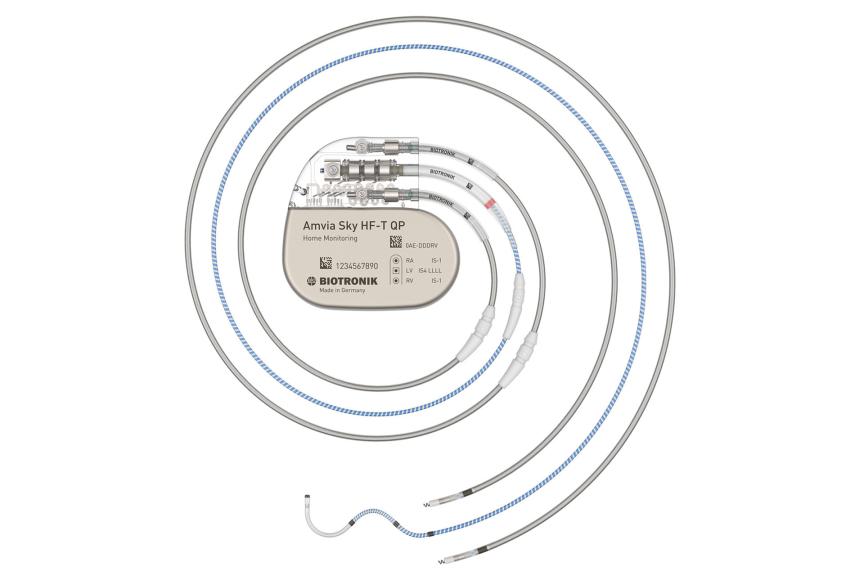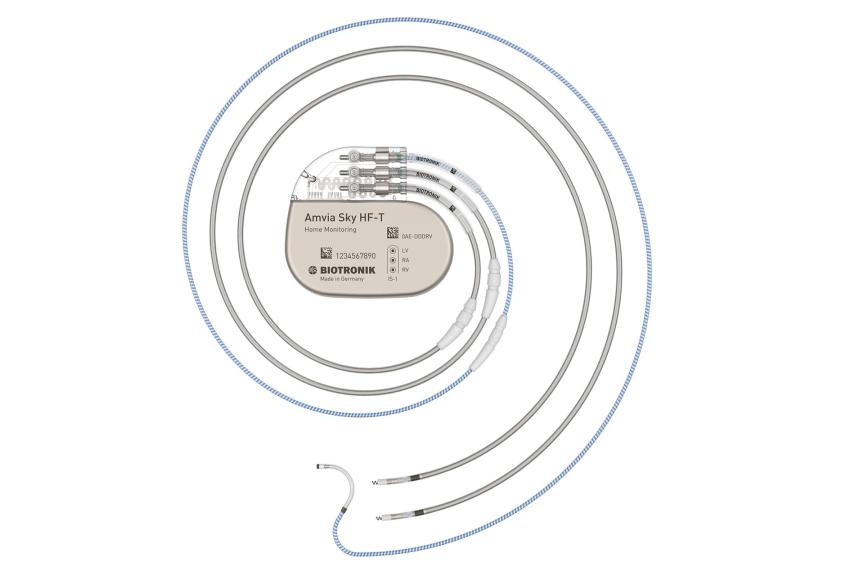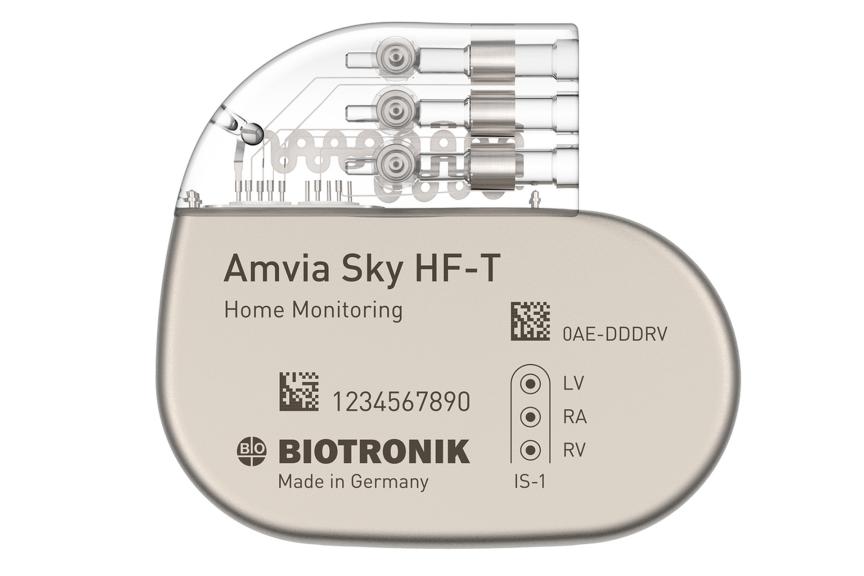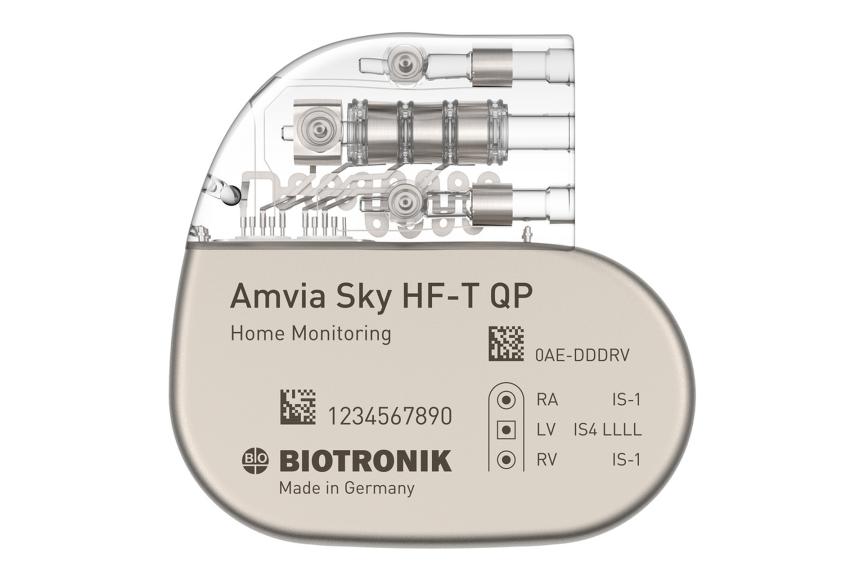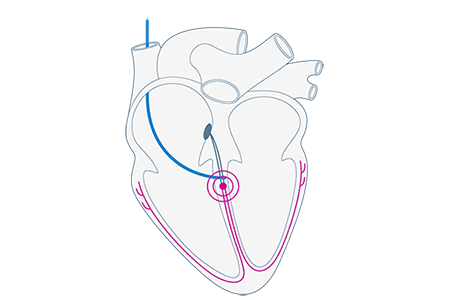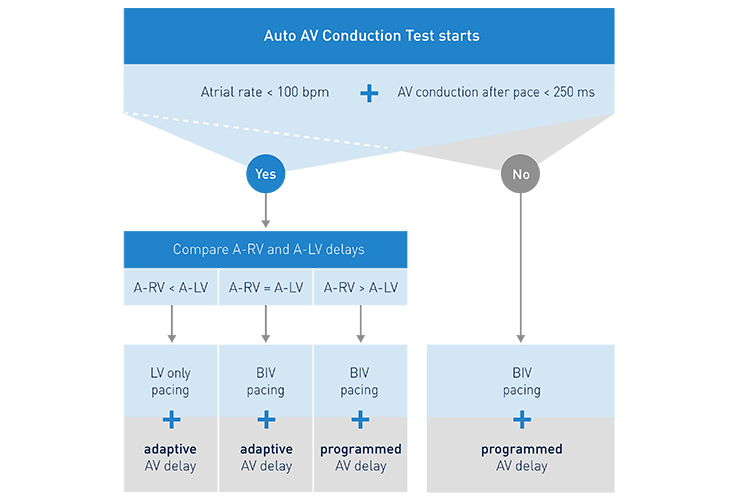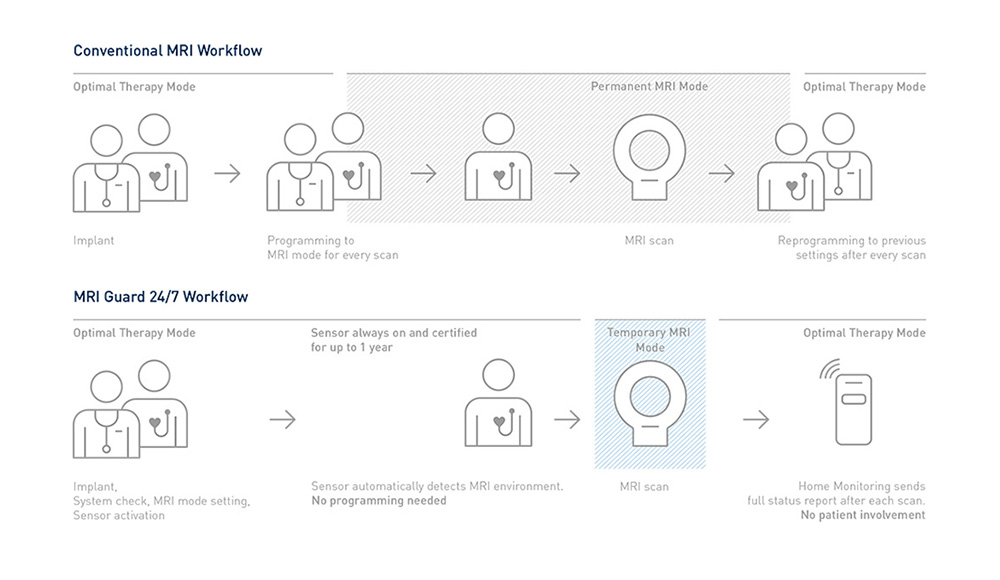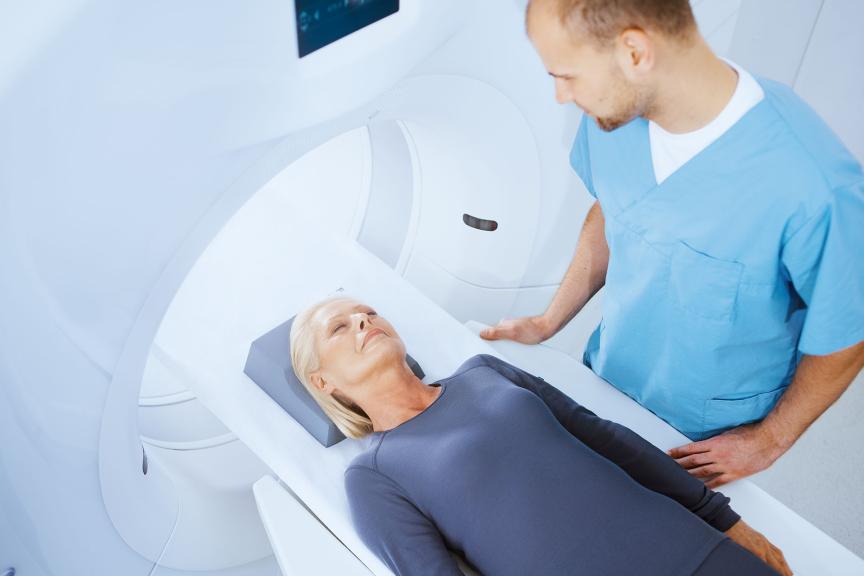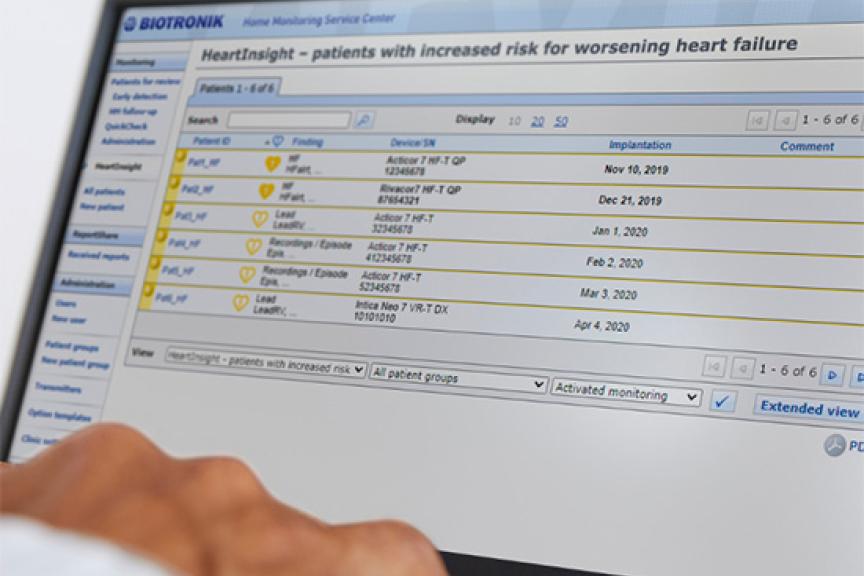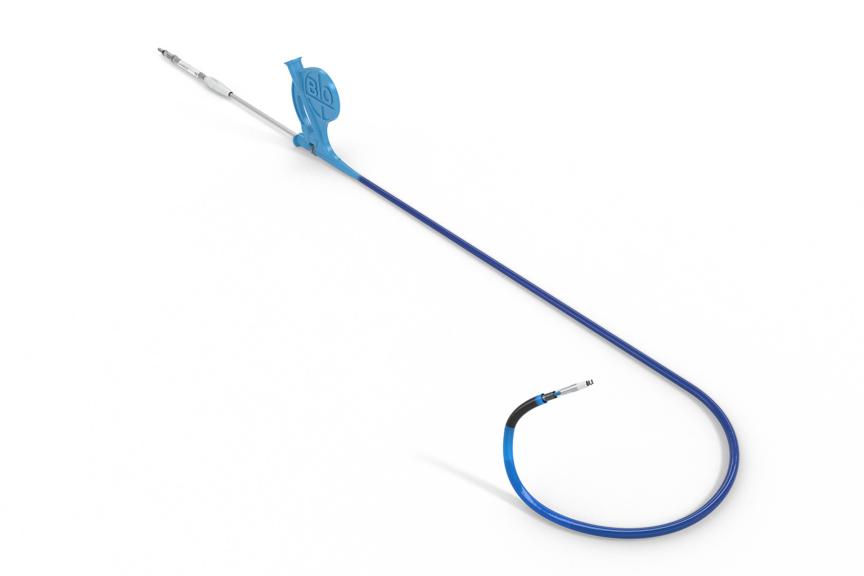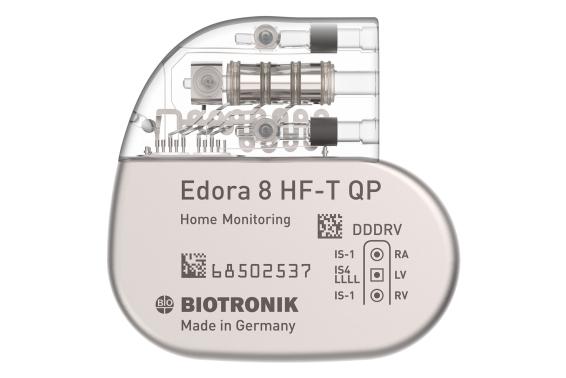Amvia Sky HF-T QP / HF-T
Met een non-responspercentage van 30 % op CRT1 is de optimalisatie van therapie essentieel voor artsen die CRT-patiënten verzorgen. Van de implantatie tot het beheer van individuele patiënten: het voldoen aan elke aandoening en behoefte is zowel veeleisend als tijdrovend voor gezondheidzorgteams.
Amvia Sky CRT-P biedt een complete set opties om aan de behoeften van u en uw patiënten te voldoen – ontworpen om de CRT-stimulatierespons te verbeteren. Van de grootste keuze aan LV-stimulatiepolariteiten2 tot unieke frequentie- en CRT-aanpassingsfuncties, Amvia Sky CRT-P biedt een automatische en eenvoudig te gebruiken3 manier om de stimulatierespons van de patiënt te optimaliseren. Amvia Sky is de eerste CRT-pacemaker die is goedgekeurd voor de stimulatie van het linkerbundeltakgebied (LBBAP)2en biedt een alternatieve methode voor het leveren van fysiologische therapie aan uw patiënten met hartinsufficiëntie. Tegelijkertijd automatiseert Amvia Sky CRT-P veel routinetaken tijdens nacontroles in de praktijk, bewaking op afstand en MRI-workflows.
Door tijdintensieve workflows te vereenvoudigen en te automatiseren kan Amvia Sky CRT-P u helpen tijd te besparen4 zodat u zich kunt concentreren op andere klinisch relevante taken, terwijl u uw patiënten het potentieel biedt van verbeterde zorg en een verhoogde kwaliteit van leven.
Hoogtepunten van product
Fysiologische stimulatie bereiken
Amvia Sky is de eerste CRT-pacemaker die is goedgekeurd voor de stimulatie van het linkerbundeltakgebied (LBBAP)2en biedt een alternatieve methode voor het leveren van fysiologische therapie aan uw patiënten met hartinsufficiëntie.
De therapie personaliseren
Amvia Sky CRT-P vermindert de benodigde inspanning4 door een uitgebreide reeks automatische opties aan te bieden om de fysiologische behandeling voor elke patiënt te individualiseren.
De zorgtrajecten stroomlijnen
Amvia Sky CRT-P biedt unieke automatische technologieën op afstand voor uw patiënten met hartinsufficiëntie waardoor mogelijk tijdrovende workflows worden gestroomlijnd langs het gehele patiëntenzorgtraject. Van implantatie en nacontroles tot monitoring op afstand en uitstekende MRI-toegang
Downloads en gerelateerde links
Neem contact met ons op
Referenties
1) Naqvi SY, Jawaid A, Goldenberg I, and Kutyifa V. Non-response to Cardiac Resynchronization Therapy. Curr Heart Fail Rep. 2018; 15: 315-321. 2) BIOTRONIK Amvia HF-T QP technical manual, Medtronic Percepta Quad CRT-P MRI SureScan™ manual; Boston Scientific Visionist X4™ technical manual; Abbott Allure Quadra MP RF™ user’s manual; MicroPort REPLY CRT-P™ implant manual. 3) Gegevens in bestand. 4) Gegevens in bestand. 4) Gegevens in bestand. 5) Vijayaraman P, Herweg B, Verma A, et al. Rescue left bundle branch area pacing in coronary venous lead failure or nonresponse to biventricular pacing: Results from International LBBAP Collaborative Study Group. Heart Rhythm. 2022; 19(8): 1272-1280. 6) Li X, Qiu C, Xie R, et al. Left bundle branch area pacing delivery of cardiac resynchronization therapy and comparison with biventricular pacing. ESC Heart Fail. 2020; 7(4): 1711–1722. 7) Wang Y, Gu K, Qian Z, et al. The efficacy of left bundle branch area pacing compared with biventricular pacing in patients with heart failure: A matched case-control study. J Cardiovasc Electrophysiol. 2020; 31(8): 2068– 2077. 8) De Pooter J, Ozpak E, Calle S, et al. Initial experience of left bundle branch area pacing using stylet-driven pacing leads: A multicenter study. J Cardiovasc Electrophysiol. 2022; 33(7): 1540-1549. 9) Lindovska M, Kameník L, Pollock B, et al. Clinical observations with Closed Loop Stimulation pacemakers in a large patient cohort: the CYLOS routine documentation registry (RECORD). Europace. 2012; 14: 1587–1595. 10) Santini M, Ricci R, Pignalberi C, et al. Effect of autonomic stressors on rate control in pacemakers using ventricular impedance signal. Pacing Clin Electrophysiol. 2004; 27: 24-32. 11) Proff J, Merkely B, Papp Ret al. Impact of closed loop stimulation on prognostic cardiopulmonary variables in patients with chronic heart failure and severe chronotropic incompetence: a pilot, randomized, crossover study Europace (2021) 23, 1777–1786. 12) Malinowski K. Interindividual comparison of different sensor principles for rate adaptive pacing PACE. 1998; 21(PT II): 2209-2213. 13) Gegevens in bestand. 14) BIOTRONIK Amvia Sky Technical Manual. 15) A/R/LV: 2.5 V/0.4 ms. 60 bpm, 500 Ω; A: pacing: 10%; RV: pacing: 50%, LV: pacing: 100%; Home Monitoring: OFF, QuickCheck: OFF; RF telemetry: OFF; CRT AutoAdapt: ON. 16) Nattel S, Burstein B, Dobrev D. Atrial remodeling and atrial fibrillation: mechanisms and implications. Circ Arrhythm Electrophysiol. 2008; 1(1): 62-73. 17) Gegevens in bestand. 18) Varma N, Epstein AE, Irimpen A, et al. Efficacy and safety of automatic remote monitoring for implantable cardioverter-defibrillator follow-up: the Lumos-T Safely Reduces Routine Office Device Follow-up (TRUST) trial. Circulation. 2010; 122(4): 325-332. 19) Mabo P, Victor F, Bazin P, et al. A randomized trial of long-term remote monitoring of pacemaker recipients (the COMPAS trial). Eur Heart J. 2012; 33(9): 1105-1111. 20) Gegevens in bestand. 21) Mullane S, Michaelis K, Henrickson C, et al. Utilization and programming of an automatic MRI recognition feature for cardiac rhythm management devices. Heart Rhythm. O2. 2021; 2: 132–137. 22) Siddamsetti S, Shinn A, Gautam S. Remote programming of cardiac implantable electronic devices: a novel approach to program cardiac devices for magnetic resonance imaging. J Cardiovasc Electrophysiol. 2022;33(5):1005–1009. 23) Ricci RP, Morichelli L, Quarta L, et al. Long-term patient acceptance of and satisfaction with implanted device remote monitoring, Europace. 2010; 12(5): 674-679. 24) Watanabe E, Yamazaki F, Goto T, et al. Remote management of pacemaker patients with biennial in-clinic evaluation: Continuous Home Monitoring in the Japanese At-Home study: A randomized clinical trial. Circ Arrhythm Electrophysiol. 2020; 13(5): e007734. doi: 10.1161/CIRCEP.119.007734. 25) Gegevens in bestand. 26) Gegevens in bestand. 27) A/R/LV: 2.5 V/0.4 ms. 60 bpm, 500 Ω; A: pacing: 10%; RV: pacing: 50%, LV: pacing: 100%; Home Monitoring: OFF, QuickCheck: OFF; RF telemetry: OFF; CRT AutoAdapt: ON. 28) Limited Warranty for BIOTRONIK Cardiac Implantable Electronic Devices; Medtronic Limited Warranty Summary; Boston Scientific Limited Warranty Information and Forms; Abbott CRM Warranty Procedures Reference Manual; MicroPort REPLY CRT-P™ implant manual.
